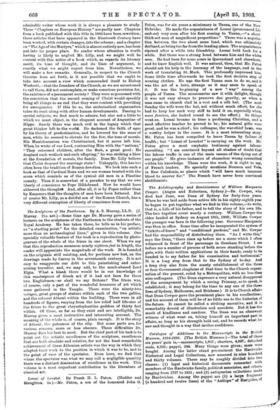The Sculptures of the Parthenon. By A. S. Murray, LL.D.
(J. Murray. 21s. net.)—Some time ago Dr. Murray gave a series of lectures on the sculptures of the Parthenon to the students of the Royal Academy. He has taken these, he tells us in his preface, as "a starting point" for the detailed examination, "on artistic more than on archaeological lines," given in this volume. One specially valuable feature of the book is a reproduction by photo- gravure of the whole of the frieze in one sheet. When we say that this reproduction measures nearly eighteen feet in length, the reader will appreciate the magnitude of the work. It is founded on the originals still existing, and, for portions now lost, on the drawings made by Carrey in the seventeenth century. It is not easy to exaggerate our debt to this painstaking and enter- prising traveller, and, we may add, to the much-abused Lord Elgin. What a blank there would be in our knowledge of this masterpiece of Groek art if it had not been for these two Englishmen—or shall we say Britons ? The frieze was, of course, only a part of the wonderful treasures of art which were gathered in the Temple. There were the ninety-two sizetopes, great groups of statues within each of the two gables, and the colossal Athens within the building. There were in all hundreds of figures, varying from the low relief half life-size of the frieze to the great chryselephantine goddess of thirty feet within. Of these, so far as they exist and are intelligible, Dr. Murray gives a most instructive and interesting account. The meaning of the whole is, of course, plain enough. It is the story of Atheni•, the patroness of the city. But some parts are, for various reasons. snore or less obscure. These difficulties Dr. Murray does his best to meet. But the chief part of his task is to point out• the artistic excellences of the sculpture, excellences that are both absolute and relative, for not the least remarkable achievement of these Athenian artists was the way in which they adapted their work to the position in which it was to be, and to the point of view of the spectator. Even here, we find that where the spectator was what we may call a negligible quantity there was a distinct diminution of excellence in the work. This volume is a most important contribution to the literature of classical art.


























































 Previous page
Previous page